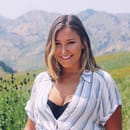One of Sundance 2020’s standout films is undoubtably Black Bear, an American drama thriller film starring Audrey Plaza and directed by Lawrence Michael Levine. Adding to the film’s notable talent is seasoned production designer, Tracy Dishman; Dishman is seasoned in her work in indie films, including Fun Mom Dinner, American Satan, Gemini, and Spivak. We were able to catch up with Dishman following Black Bear’s Sundance 2020 premiere.
HC: Your position holds a unique and extremely important responsibility within film; what drew you to the career path of production design? Was working in film always the plan?
TD: Oh, thank you for saying that! I think it’s important too! But no, film was not always the plan. I got my bachelors at a progressive liberal arts school, shout out Evergreen State College, where I studied things like the personalities of cities and the cultural impact of Harry Potter. I was working in vintage clothing in Seattle before moving to L.A. in 2005 where I had friends here in the industry. Soon after being in L.A. I got thrown on the set of a short film where I was basically just an extra set of hands, but by the end of that shoot I had my next movie lined up. How I got into designing was by working my way up through the art department, learning on the job, and jumping at opportunities as they arose.
HC: How do you compare the first production you worked on to Black Bear? What has changed in your work ethic since then?
TD: Well, on my first production I knew nothing. I literally didn’t know how to use a walkie. My first paid job was assistant prop master on a corrupt cop feature. We were on night shoots in downtown L.A. and the props I was in charge of were all weapons and drugs. It’s almost a blessing I was so inexperienced because I think I was fearless in my ignorance. But I wanted to learn and I was aggressive in seeking out resources. So I went to the shooting range at the prop house and got my firearms license, I learned about blanks and squibs and safety and all of that. My first 5 years in the industry I did props and was dialed in on the minutiae of a project, married to the set, and always with the shooting crew. Cut to Black Bear and my role is very different. As a designer I oversee several departments and work in cooperation with the rest. My focus is now much more macro, and I’m juggling a lot of logistics while delivering creative pitches. In my work ethic I’d say I’m as driven and focused as I’ve always been, but I’m probably much more patient now than I was in the beginning.
HC: Black Bear is undoubtedly a striking film: what specifically drew you to the project?
TD: I was originally contacted by Rick Bosner, a producer I’ve worked with on several projects and who’s judgement I completely trust. Next, I read the script and it was unlike anything I had done and I was thrilled at the idea of something so surreal and out there. Then I met with Lawrence Michael Levine, our writer/director, and we just hit it off. We’re both quirky and and have strong aesthetic sensibilities, so we were just on the same page immediately. Another influencing factor was I knew we would be shooting in the Adirondack State Park and I hadn’t shot in New York at that point, so it was another opportunity to expand my skill set. And lastly, we had a locked cast at that point and Aubrey Plaza, Sarah Gadon and Christopher Abbott are all such strong actors I knew it was going to be an amazing project.
HC: Production design helps the audience escape to an alternate reality, and Black Bear explores a similar notion of alternate realities. What was it like to explore this concept of dual realities within your work on this specific film?
TD: It was a blast and super meta. This film is the thought experiment of alternate roles and alternate outcomes. We have one storyline which is the first half of the film, the alternate storyline which is the second half of the film, and then there was reality with its own footprint. The real cast and crew were staying in and around our hero location, and in the second vignette the actors are all playing cast and crew members, so it got very “who’s on first?” For example, are we talking about the real script supervisor, the character script supervisor, or the actor who’s playing the part of the script supervisor?
HC: The plot of Black Bear is divided into two parts. Was your creative process different with working on each half of the film? Was it a challenge to work on two different yet intertwined stories within one film?
TD: My creative process is always intuitive and in service of the story, so that was my approach to both parts of the film. On this particular project I worked closely with our Cinematographer, Rob Leitzell, and our Costume Designer, Allie Pearce, and collectively we tracked all the elements crucial to the tone of the acts. Allie and I came up with a specific color palette but we wanted it to be nuanced and clean, so we charted out which of us would provide the pops of color and in which scenes they would be most effective. Rob utilized different shooting techniques in each act so we were sensitive to giving him either space or obstacles depending on the energy of a given scene. So the challenge was all in the prep, once we started shooting it all fell into place.
HC: What was the most challenging part of working on Black Bear?
TD: The overwhelming challenges were we had no cell service and no wifi and were in the middle of nowhere for 5 weeks. Also, black flies.
HC: How do your relationships with your film crew shape your work? What was it like to work with director Lawrence Michael Levine?
TD: Relationships are everything. There are a lot of personalities on a movie set and ideally it’s a collection of creative professionals who have all been drawn to a project for a reason and who want to support each other. It really can be a lovefest where you make friends for life. And…sometimes it doesn’t work out like that. So, for me, it’s important to not take things personally and keep the focus on the job at hand. On Black Bear I was blessed with amazing local talent and was able to bring the set decorator, Jenni Durban, in from Montana. We had worked together before and in addition to being an incredibly talented decorator, she is an experienced outdoors woman, so that came in handy. It was such a challenging project there was just no room for difficult personalities. Like it’d be the middle of the night and the power would go out and we’d be like, “I’m sure glad I like you guys.” Working with Larry specifically was awesome. He had already directed several movies so he anticipated challenges and was selective in what he was non negotiable on, which is helpful when you have limited resources. As a writer, he had a clear vision of what he wanted, he trusted me to deliver, wanted my input, and respected my opinion on things, which is basically fuel to the creative fire. I would work with him again in a heartbeat.
HC: Any advice to anyone aspiring to break into the film industry and maybe someday see their film as a Sundance feature?
TD: If Sundance is your goal, you’re probably working in independent film, which means there’s a good chance you’re in the low budget world. So my advice would be do the projects that you’re drawn to and think are great, but at a certain point be mindful of your worth. Working for low or no pay is not unheard of and is a way to get experience and credits, especially when you’re just starting out, but it’s also not sustainable. The design process is subjective and personal and art, but movie making is a business and at the end of the day it’s your job. Negotiate as you grow, ask your peers what they’re making and how they advocate for themselves, and don’t be afraid to walk away from an opportunity if it doesn’t feel right.
HC: What’s next for you?
TD: I try to balance my work between film and television and to not get pigeon holed in any one genre. My next gig is in February when I head back to Savannah, Georgia for season 2 of Florida Girls (PopTV). It’s basically the exact opposite of Black Bear in that it’s super colorful, beach-y, and is a half-hour cable comedy that follows 4 girls who live in a trailer park together. After that, probably another feature and who knows, maybe I’ll be back at Sundance next year!


